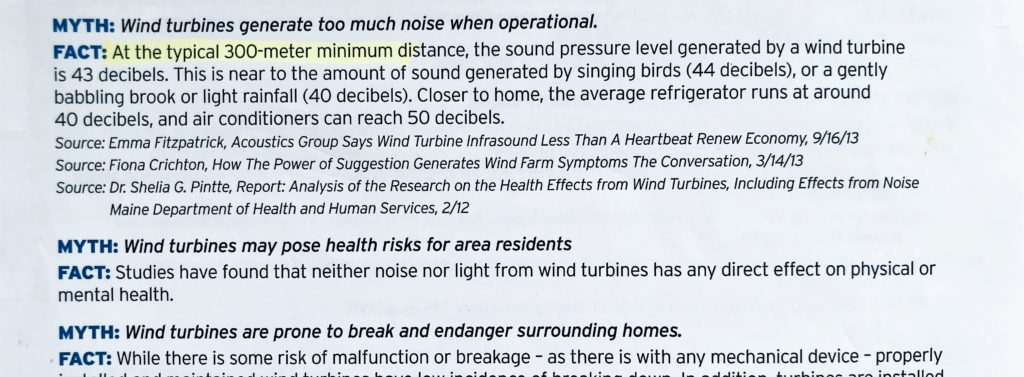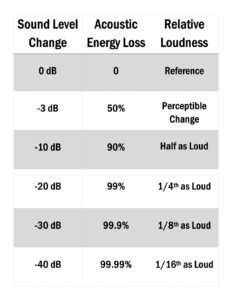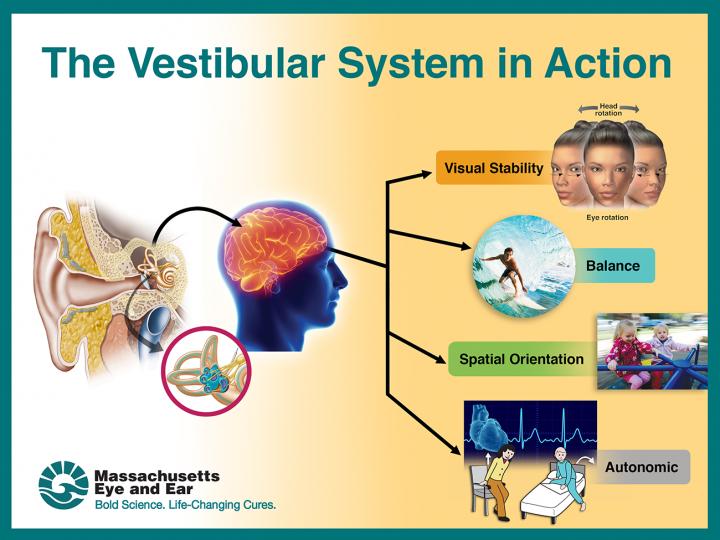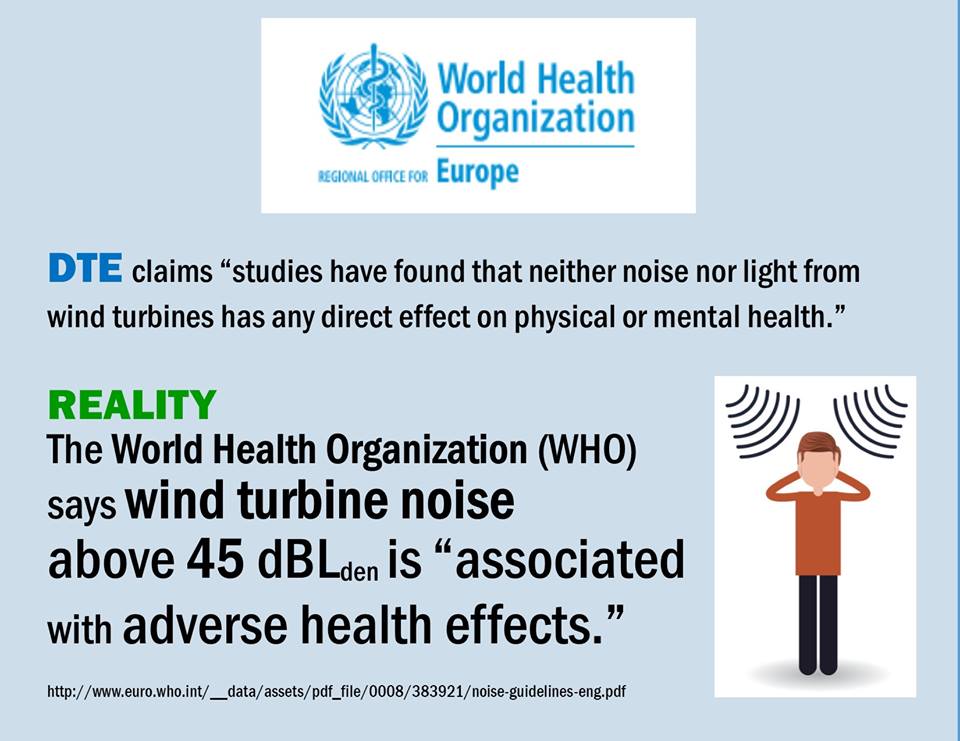The Reality of Industrial Wind in Michigan: Part 2
Below is the second part in a series of posts, refuting DTE’s alleged “facts” about Industrial Wind. (You can find Part 1 of the series here: https://ourdirtroadfarm.com/rural-communities-and-their-castles/)
Our grassroots Coalition finds itself cast in a modern day rendition of David versus Goliath that we never wanted to be in. But the good news is that David conquered Goliath — and so will we.
What I have learned, and observed, about how DTE does business is so disheartening. The extent to which DTE and their subcontractors will try to manipulate the “facts” of Industrial Wind stomps all over decency.
One of the few pieces of literature DTE gave out to prospective lease holders was a sheet called, “Get the Facts Straight on Wind Energy.” It says, “Here’s what you should know about how wind turbines work and why expanded wind energy is good for Michigan.” DTE proceeds to list the various “myths” about wind energy and then shared their version of the “facts.” Unfortunately, the majority of DTE’s “facts” were misleading — and in other cases downright false.
So, when it came time for us to publicly give our rebuttal and share our own concerns, we shared our own review of the information behind DTE’s proposed “facts.” Because there is a third entirely different category: REALITY.
Look away…nothing to hear?!
DTE’s MYTH: Wind turbines generate too much noise when operational.
DTE’s FACT: At the typical 300-meter minimum distance, the sound pressure level generated by a wind turbine is 43 decibels. This is near to the amount of sound generated by singing birds (44 decibels), or a gently babbling brook or light rainfall (40 decibels). Closer to home, the average refrigerator runs at around 40 decibels, and air conditioners can reach 50 decibels.
Source: Emma Fitzpatrick, Acoustics Group Says Wind Turbine Infrasound Less Than a Heartbeat, Renew Economy, 9/16/13
Source: Fiona Crichton, How the Power of Suggestion Generates Wind Farm Symptom The Conversation, 3/14/13
Source: Dr. Sheila G. Pinette, Report: Analysis of the Research on the Health Effects from Wind Turbines, Including Effects from Noise, Maine Department of Health and Human Services, 2/12

Since understanding the specifics about noise can be a little tricky, maybe taking a closer look at the sources that DTE references would be a reasonable place to start this discussion dissection.
In the article located here, https://reneweconomy.com.au/acoustics-group-says-wind-turbine-infrasound-less-than-a-heart-beat-92994/, the reporter says the study “rejected claims that the frequencies created by wind turbines can have adverse health issues, saying the infrasound generated is often less than a person’s heart-beat.” That phrase, “quieter than a person’s heart beat,” got a lot of play in the media and trade publications.

A person’s heart beat is pretty quiet. So hey, what’s the big deal?
You can read the study here yourself. It’s entitled, “Infrasound Levels Near Windfarms and in Other Environments.” It was done in Australia. https://waubrafoundation.org.au/wp-content/uploads/2013/06/EPA-Infrasound-Lenchine-EtAl-2013.pdf
In regards to rural environment, the aussie acousticians find that “this study concludes that the level of infrasound at houses near the wind turbines assessed is no greater than that experienced in other urban and rural environments, and that the contribution of wind turbines to the measured infrasound levels is insignificant in comparison with the background level of infrasound in the environment.”
My oversimplified summary of their summary — they conclude that turbine infrasound is nothing to worry our pretty little rural heads over.
But, once again, there is more to the headline and catchy claims.
Just look at how daunting the legwork for the aussie’s “study” must have been — they collected data from TWO homes near turbines.
TWO.
Two homes that were defined as “near” and “adjacent to” the wind turbines.
The house “near” the turbine was 1.5 km — or .93 miles — away from the turbine. And the house “adjacent to” the wind turbine was 1.4 km — or .87 miles — away from the turbine. (And just for a point of reference, DTE’s handout says that 300 meters is a typical setback from a home. 300 meters is .186 miles. Hmm, wonder why DTE didn’t reference any studies made with homes within .186th of a mile for proof of their “fact”?!)

Just for kicks, wanna guess what those two houses were made of?
They were brick.
Wanna guess how noise travels through brick compared to a stick built house?
The researchers then compared the infrasound of those two brick homes to the infrasound measured at two different homes — one 10 km and the other 30 km — from the nearest wind turbine.
And nowhere in that entire study did it compare turbines to the sound of a heartbeat. But please don’t take my word for it — please check it yourself.
Yep, as Paul Harvey used to say, “that’s the rest of the story.”
It’s all in your head
The second source that DTE shows to support its claims about turbine noise doesn’t fare much better when we take a look at it. This was the study called, “How the Power of Suggestion Generates Wind Farm Symptoms, The Conversation.” https://pdfs.semanticscholar.org/23b9/12b9d0da446f45d0958dd2ac5ec57b10f084.pdf

It was conducted at the University of Auckland and it exposed 50 or so college students to 20 minutes of testing. On campus. In a booth. With a stereo. The researchers had the students listen to 10 minutes of “noise” on a stereo and then 10 minutes of “silence.”
Take a look at that study name again — how the power of suggestion generates wind farm symptoms. Based on 20 minutes of testing. With college students. Listening to sound via a stereo. There were no turbines. There was no exposure to improper placement of a 500′ tall turbine. Just 20 minutes of listening.
If this subject wasn’t such a serious one, these source materials that DTE provided might be laughable. But this isn’t laughable. DTE’s choice of references suggests that if you think that turbines are too loud, it must be all in your head.
A Little Sound 101
Sound scales take a little understanding — they are logarithms. Acoustics experts say that just a 5 dB change is significant. “The pressure associated with the loudest known sound is more than one billion times that associated with the faintest sound. Such a large range is unmanageable for measurement purposes. Using a logarithmic scale compresses the range to between 0 to 200 dB.” Here’s what various sound level changes equate to relative loudness and acoustic energy loss.

IAC Acoustics: Industrial Noise Control http://www.industrialnoisecontrol.com/inc-library/noise-control-faqs
Another key point in understanding sound is that it is multi-dimensional. It includes magnitude (like the decibels, loudness, amplitude and strength), frequency (wavelength of noise, pitch, rumbling and humming) and duration (intermittent, short bursts or constant.)
Our ears serve as our centers for balance and spatial equilibrium — without which our brains wouldn’t have the necessary information to understand our body’s relationship with its environment. It is our vestibular system which provides us with a sense of balance and awareness.

Researchers describe turbine noise as “often deemed more annoying than the hum or roar of transportation noise because of its repetitive nature and high variability in both level and quality — from ‘swoosh’ to ‘thump’ to ‘silence’, all modulated by wind speed and direction. This pulsing, uneven quality enables the noise to repeatedly capture the attention and become more difficult to ignore.”
What DTE doesn’t tell you is that when IWTs are improperly sited too close to homes, residents describe the sound generated by them as comparable to a bumble bee buzzing in your ear, the constant lull of a dryer tossing around a pair of tennis shoes, a jet engine in the backyard, and diesel engines running.
A rural nighttime noise level is approximately 28-30 dBA. An increase of +10 dBA is dramatic – and sounds nearly twice as loud to the human ear.
http://www.industrialnoisecontrol.com/comparative-noise-examples.htmS
The World Health Organization recently updated their Environmental Noise Guidelines — stating that “wind turbine noise above 45 dBLden is “associated with adverse health effects.” This is encouraging news for all our rural communities fighting improper siting! The discussion on Industrial Wind Turbines begins on page 77 of the PDF, so you can review for yourself. http://www.euro.who.int/__data/assets/pdf_file/0008/383921/noise-guidelines-eng.pdf?fbclid=IwAR2kW-HW2Kz9WlL5sMgPWewsmWU8RTmHIMlcNsJ_Uhj4KwEqndaZ0MVLKG4

Clearly, the research has not been able to address all variables yet, as supersized turbines are in their infancy stage — but this is an important first step and acknowledgement from the WHO. (Thank you to the WHO for speaking for people and not profits!)
This leads us into DTE’s next claim that neither noise nor light from wind turbines will not compromise or have any direct impacts on your physical or mental health.
DTE’s MYTH: Wind turbines may pose health risks for area residents.
DTE’s FACT: Studies have found that neither noise nor light from wind turbines has any direct effect on physical or mental health.
DTE didn’t show any supporting sources for this particular “fact.” But it’s how they operate. Distorting their sales pitch to the point of unethical conduct is par for the course. If you have ever sat in on any of DTE’s sales meetings and heard them talk about this particular issue, I am willing to bet you have heard the phrase, “no one has ever gone to the hospital” because of one of their turbines.
Typical DTE deception. People don’t generally go the hospital for sleep disturbances, sleep deprivation, elevated blood pressure, increased stress hormones, headache, tinnitus, vertigo, tension, stress, diabetes, undue fatigue, annoyance, psychological distress, inability to concentrate, anxiety, etc, etc, etc. (All issues reviewed in the literature resourced below, in regards to turbine noise and health issues.)

And DTE knows that. Because the reality of the situation is that NUMEROUS researchers have documented quite the contrary to DTE’s baloney.
REALITY: “There is enough evidence to indicate that infrasound and low-frequency noise from IWTs causes annoyance, sleep disturbance, stress, and a variety of other adverse health effects to warrant siting the turbines at a minimum distance of 1.25 miles away from property lines to sufficiently avoid such harmful effects.”
Source: Wind Turbine Noise & Human Health: A Four-Decade History of Evidence that Wind Turbines Post Risks, Punch, J, Department of Communicative Sciences and Disorders, Michigan State University, Richard, James, Department of Communication Disorders, Central Michigan University, October 21, 2016.
https://hearinghealthmatters.org/journalresearchposters/files/2016/09/16-10-21-Wind-Turbine-Noise-Post-Publication-Manuscript-HHTM-Punch-James.pdf
REALITY: Environmental noise can in turn affect physical health.
Source: Pedersen, Persson, Perception and Annoyance Due to Wind Turbine Noise, 2004; Pedersen, Response to Noise from Large Wind Turbines, Acoust Soc Am, 2009 Public Health Division, Strategic Health Impact Assessment On Wind Energy Development in Oregon, March 2013.
https://www.ncbi.nlm.nih.gov/pubmed/15658697
https://docs.wind-watch.org/Pedersen_Response-to-wind-farm-noise-Netherlands.pdf

REALITY: Wind turbine noise and shadow flicker can induce adverse human health effects, including annoyance and/or stress.
Source: Public Health Division, Strategic Health Impact Assessment On Wind Energy Development in Oregon, March 2013, p. 6-7, 25-26,27-29, 34; Pedersen, E., Health aspects associated with wind turbine noise – results from three field studies. Journal of Noise Control Engineering, 2011. Pedersen, E., et al., Response to noise from modern wind farms in The Netherlands. The Journal of the Acoustical Society of America, 2009. Pedersen, E. and K.P. Waye, Wind turbine noise, annoyance, and self-reported health and wellbeing in different living environments. Occupational and Environmental Medicine, 2007. Shepherd, D., et al., Evaluating the impact of wind turbine noise on health-related quality of life. Noise and Health, 2011.
Please review pages 27-35 of the report prepared by the Public Health Division in the state of Oregon. Their “Strategic Health Impact Assessment on Wind Energy Development in Oregon” was one of the few thorough, common sense, researched and reviewed reports I could find.
https://www.oregon.gov/oha/PH/HEALTHYENVIRONMENTS/TRACKINGASSESSMENT/HEALTHIMPACTASSESSMENT/Documents/Wnd%20Energy%20HIA/Wind%20HIA_Final.pdf
REALITY: Research that considered indirect pathways has yielded evidence strongly suggesting the potential for harm.
Environmental Health perspectives, A Different Breed of Noise, Volume 122, Number 1, January 2014, p. 22-24.
https://ehp.niehs.nih.gov/doi/10.1289/ehp.122-A20
So how do you suppose it is, with all the corporate resources that a company like DTE has, that they couldn’t find ONE single source for their “fact” in regards to health risks for area residents?
Forgive me if I sound jaded when I say, this is yet another one of the many reasons why I don’t trust DTE.
But even more than that, this is precisely how DTE turns rural residents like me, into motivated grassroots activists, who will not stop fighting to expose their unethical tactics and deceptions.
Because they are full of hogwash.
If you can’t safely site your turbine without compromising my community’s health and welfare, then you shouldn’t build it in my community.
(And we will have more to say about DTE’s hogwash in another part of this series.)